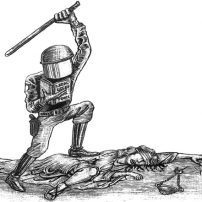
Violence in football matches. Police officers must wear distinctive indentifying signs.
JUDGMENT
Hentschel and Stark v. Germany 9.11.2017 (no. 47274/15)
SUMMARY
The case concerned the complaint by two football supporters of having been ill-treated by the police
following a match and of the inadequacy of the ensuing investigation.
The Court was unable to establish beyond reasonable doubt that the events had happened as
described by the applicants.
As regards the investigation, the Court observed in particular that the helmeted police officers of the
riot control units had not worn any name tags or other individually identifying signs, but only
identification numbers on the back of their helmets. Therefore, other measures to establish the
identities of the persons responsible for the alleged ill-treatment had become especially important.
However, the difficulties resulting from the lack of identifying insignia had not been sufficiently
counter-balanced by other investigative measures. Notably, only excerpts of the video material
recorded by the riot units had been provided to the investigating unit and some potentially relevant
witnesses had not been identified and questioned.
PROVISION
Article 3
PRINCIPAL FACTS
The applicants, Ingo Hentschel and Matthias Stark, are German nationals who were born in 1969 and
1989 and live in Illertissen and Harburg (Germany) respectively.
Both applicants attended a football match in Munich on 9 December 2007. Over 200 police officers
were deployed during the match, including several riot control units, in view of an expected risk of
clashes between rival football supporters. After the end of the match the police cordoned off the
supporters of one team, including the applicants, for about 15 minutes to prevent them from
encountering supporters of the other team.
Mr Hentschel submits that, on their way to the exit after the cordon had been lifted, spectators were
approached by a group of police officers, some of whom started hitting them with their truncheons
without any prior warning. He alleges that he was hit on his head with a truncheon, resulting in a
bleeding wound treated by a paramedic after he had exited the stadium and subsequently requiring
further treatment in hospital. According to Mr Stark, before exiting the stadium he was grabbed by
the shoulder by a police officer who used pepper spray on his face at close range. He alleges that,
when subsequently lying down on the ground, he was struck on his arm with a truncheon.
According to the Government’s submissions there was no credible evidence that the applicants were
deliberately hit or harmed by police officers.
Following media reports on football supporters’ accounts of arbitrary attacks by police officers in the
aftermath of the match, the Munich public prosecutor’s office opened a preliminary investigation in
January 2008. The applicants, who had identified their attackers as police officers but had been
unable to distinguish them further, owing to their identical uniforms without identifying signs or
name tags, both filed criminal complaints against unidentified police officers.
In September 2008 the public prosecutor discontinued the investigation. He found that there was
evidence that some police officers had used truncheons in a disproportionate way but concluded
that it had been impossible to identify the suspects. On appeal by the applicants, the public
prosecutor reopened the investigation in October 2008, ordering further enquiries. In August 2009,
the public prosecutor again discontinued the investigation, finding in particular that several football
supporters had aggressively approached, insulted and provoked the deployed police officers and
that in that situation the officers could have been justified in using their truncheons. The decision
was confirmed by the Munich general public prosecutor in 2011. In September 2011 the Munich
Court of Appeal declared inadmissible the applicants’ action to force further enquiries. In March
2015 the Federal Constitutional Court delivered a reasoned decision (file no. 2 BvR 1304/12) refusing
to admit the applicants’ constitutional complaint.
THE DECISION OF THE COURT
Article 3 (treatment)
The Court observed that it was confronted with a dispute over the exact events after the football
match on 9 December 2007. It underlined that its role was a subsidiary one and that it had to be
cautious in taking on the role of a first-instance tribunal of fact, where this was not rendered
unavoidable by the circumstances.
The Court noted that the police cordon following the match had blocked only the exits of the
stadium for about 15 minutes. Supporters had still been able to move freely within the stands. The
alleged police violence had happened, according to the applicants, after the blockade had been
lifted and the applicants had left the stands. The Court therefore concluded that the applicants had
not been under the control of the police, which would have shifted the burden of proof to the Government. Consequently, it had been for the applicants to substantiate their factual arguments by providing the Court with the necessary evidence.
As to the medical certificates submitted by the applicants, the Court considered that they attested to
possible consequences of ill-treatment, namely being beaten with a truncheon on the head and
having pepper spray applied to the face from a close distance. However, the certificates did not
attest to the specific cause of the injuries. Moreover, Mr Stark’s medical certificate had only been
issued six weeks after the alleged ill-treatment and was not based on an examination of the actual
injuries.
While some of the witness statements submitted by the applicants and the press reports described
the police operation in terms similar to the applicants’ accounts, the applicants had not submitted
any witness statements or other evidence directly confirming their accounts, and none of the
persons interviewed in the domestic investigation had witnessed the alleged acts. Moreover, Mr
Hentschel had reported the alleged police violence only six weeks after the events in question, and
both applicants had filed their criminal complaints only several months after those events.
In sum, the Court was unable to establish beyond reasonable doubt that the events had happened
as described by the applicants. There had therefore been no violation of Article 3 in respect of their
treatment by the police (substantial aspect).
Article 3 (investigation)
The Court considered that the applicants had raised an arguable claim of ill-treatment by the police
which had to be effectively investigated by an independent national authority.
As to the independence of the investigation, the Court found no sufficient hierarchical, institutional
or practical connection between the police unit investigating the alleged police violence and the riot
control unit under investigation which, by itself, would have rendered the investigation unreliable or
ineffective. The investigation had not been conducted by a separate police force – which would have
been desirable – but by a division of the Munich police specialising in offences perpetrated by public
officials. However, the investigating officer had not been a direct colleague of the officers of the riot
control unit and the only link between these two divisions was their common Chief of Police and the
fact that they belonged to the Munich police. The Court nevertheless emphasised that it was
important that the manner in which such types of investigations were conducted also gave an
appearance of independence so as to preserve public confidence.
The Court was satisfied that the investigation had been sufficiently prompt and expedient. The
Munich police had opened a preliminary investigation after they had been alerted by press reports
to allegations of police violence in the context of the football match on 9 December 2007. Based on
the documents in the case file, the Court did not detect any long periods of inactivity during the
investigation, which had lasted 19 months before it was discontinued. The Court observed that the
applicants had lodged their official complaints only in March and April 2008 respectively.
Consequently, the authorities had been able to investigate their specific complaints only then, and
the delay in lodging the complaints had prevented the authorities to promptly order a forensic
examination of the applicants’ injuries.
However, as regards the investigative measures actually undertaken, the Court observed that the
deployed helmeted police officers of the riot control units had not worn any name tags or other
individually identifying signs, but only identification numbers on the back of the helmets. Therefore,
other measures to establish the identities of the persons responsible for the alleged ill-treatment
had become particularly important.
As to the video material recorded by the riot units, the Court observed that the investigating unit
had only been provided with excerpts of the original video material. The Government had not clearly
explained whether the entire video material was analysed by an independent unit, why only excerpts of the video material had been provided to the investigating unit, or when the video material was deleted and by whom.
Concerning other investigative measures potentially capable of counterbalancing the failure to
secure all the video footage and to have it analysed by independent investigating units, the Court
acknowledged that around 40 witnesses had been questioned, including the squad leaders of the
deployed riot control units. However, not all officers deployed in the area where the applicants had
allegedly been ill-treated had been interviewed. Moreover, the officers in charge of the video
recordings had only been interviewed after the investigation had been reopened in October 2008
and no efforts had been undertaken to identify and question the paramedic who had allegedly
treated Mr Hentschel at the stadium.
Since those obvious lines of inquiry had not comprehensively been followed, the Court found that
the deployment of helmeted police officers without identifying insignia and any difficulties resulting
from it had not been sufficiently counter-balanced during the investigation. The Court therefore
concluded that there had not been an effective investigation, in violation of Article 3 (procedural
aspect).
Just satisfaction (Article 41)
The Court held that Germany was to pay each applicant 2,000 euros (EUR) in respect of nonpecuniary
damage and EUR 6,575.41 in respect of costs and expenses.
Separate opinions
Judge Hüseynov expressed a concurring opinion which is annexed to the judgment(echrcaselaw.com editing).


